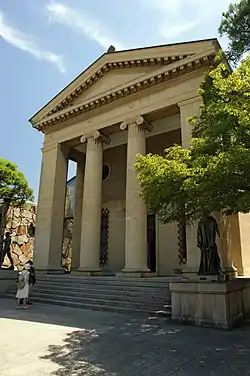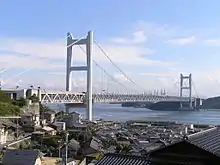Kurashiki
Kurashiki (倉敷市, Kurashiki-shi) is a city located in Okayama Prefecture, Japan. As of 31 March 2023, the city had an estimated population of 478,651 and a population density of 1300 persons per km².[1] The total area of the city is 355.63 square kilometres (137.31 sq mi).
Kurashiki
倉敷市 | |||||||||
|---|---|---|---|---|---|---|---|---|---|
| |||||||||
 Flag  Chapter | |||||||||
Location of Kurashiki in Okayama Prefecture | |||||||||
 | |||||||||
 Kurashiki Location in Japan | |||||||||
| Coordinates: 34°35′06″N 133°46′20″E | |||||||||
| Country | Japan | ||||||||
| Region | Chūgoku (San'yō) | ||||||||
| Prefecture | Okayama | ||||||||
| Government | |||||||||
| • Mayor | Kaori Itō | ||||||||
| Area | |||||||||
| • Total | 355.63 km2 (137.31 sq mi) | ||||||||
| Population (March 31, 2023) | |||||||||
| • Total | 478,651 | ||||||||
| • Density | 1,300/km2 (3,500/sq mi) | ||||||||
| Time zone | UTC+09:00 (JST) | ||||||||
| City hall address | 640 Nishinakashinden, Kurashiki-shi, Okayama-ken 710-8565 | ||||||||
| Climate | Cfa | ||||||||
| Website | Official website | ||||||||
| Symbols | |||||||||
| Bird | Kingfisher | ||||||||
| Flower | Wysteria | ||||||||
| Tree | Camphor | ||||||||

Geography
Kurashiki is located in the south-central part of Okayama Prefecture, and the Takahashi River flows through the midwestern part of the city from north to south and empties into the Seto Inland Sea. Most of the plains are occupied by reclaimed land and alluvial plains, and are relatively flat except for the Kojima area. Kojima, Kameshimayama, Tamashima, and Tsurajima are many places in the city that have the kanji 'island' in their names; these areas were originally islands and were connected by land reclamation to form the current city limits. Okayama City, which is the prefectural capital, is adjacent to the east, and Kurashiki forms part of the Greater Okayama metropolitan area.
Adjoining municipalities
Climate
Kurashiki has a humid subtropical climate (Köppen climate classification Cfa). The average annual temperature in Kurashiki is 15.8 °C (60.4 °F). The average annual rainfall is 1,042.2 mm (41.03 in) with September as the wettest month. The temperatures are highest on average in August, at around 27.9 °C (82.2 °F), and lowest in January, at around 4.6 °C (40.3 °F).[2] The highest temperature ever recorded in Kurashiki was 37.1 °C (98.8 °F) on 8 August 1994; the coldest temperature ever recorded was −8.0 °C (17.6 °F) on 27 February 1981.[3]
| Climate data for Kurashiki (1991−2020 normals, extremes 1979−present) | |||||||||||||
|---|---|---|---|---|---|---|---|---|---|---|---|---|---|
| Month | Jan | Feb | Mar | Apr | May | Jun | Jul | Aug | Sep | Oct | Nov | Dec | Year |
| Record high °C (°F) | 16.1 (61.0) |
22.5 (72.5) |
23.5 (74.3) |
30.5 (86.9) |
32.6 (90.7) |
35.2 (95.4) |
36.8 (98.2) |
37.1 (98.8) |
36.0 (96.8) |
32.4 (90.3) |
25.4 (77.7) |
19.9 (67.8) |
37.1 (98.8) |
| Average high °C (°F) | 9.2 (48.6) |
10.0 (50.0) |
13.6 (56.5) |
19.3 (66.7) |
24.4 (75.9) |
27.3 (81.1) |
30.9 (87.6) |
32.2 (90.0) |
28.4 (83.1) |
23.1 (73.6) |
17.1 (62.8) |
11.5 (52.7) |
20.6 (69.1) |
| Daily mean °C (°F) | 4.6 (40.3) |
5.2 (41.4) |
8.5 (47.3) |
13.9 (57.0) |
19.1 (66.4) |
22.9 (73.2) |
26.9 (80.4) |
27.9 (82.2) |
23.9 (75.0) |
18.0 (64.4) |
12.0 (53.6) |
6.7 (44.1) |
15.8 (60.4) |
| Average low °C (°F) | 0.3 (32.5) |
0.6 (33.1) |
3.5 (38.3) |
8.6 (47.5) |
14.0 (57.2) |
19.1 (66.4) |
23.6 (74.5) |
24.4 (75.9) |
20.1 (68.2) |
13.5 (56.3) |
7.3 (45.1) |
2.4 (36.3) |
11.5 (52.6) |
| Record low °C (°F) | −5.4 (22.3) |
−8.0 (17.6) |
−3.5 (25.7) |
−0.8 (30.6) |
3.1 (37.6) |
9.8 (49.6) |
16.0 (60.8) |
17.1 (62.8) |
8.9 (48.0) |
2.7 (36.9) |
−0.9 (30.4) |
−4.1 (24.6) |
−8.0 (17.6) |
| Average precipitation mm (inches) | 34.4 (1.35) |
42.4 (1.67) |
78.2 (3.08) |
82.5 (3.25) |
101.9 (4.01) |
149.8 (5.90) |
154.1 (6.07) |
81.3 (3.20) |
133.0 (5.24) |
93.6 (3.69) |
51.2 (2.02) |
40.4 (1.59) |
1,042.2 (41.03) |
| Average precipitation days (≥ 1.0 mm) | 4.8 | 6.1 | 8.6 | 9.0 | 8.8 | 10.6 | 9.9 | 6.8 | 8.8 | 7.1 | 5.8 | 5.2 | 91.5 |
| Mean monthly sunshine hours | 152.5 | 144.5 | 175.7 | 189.8 | 199.2 | 143.1 | 173.0 | 206.5 | 155.2 | 166.7 | 149.7 | 145.8 | 2,001.3 |
| Source: Japan Meteorological Agency[3][2] | |||||||||||||
Demographics
Per Japanese census data, the population of Kurashiki in 2020 is 474,592 people.[4] Kurashiki has been conducting censuses since 1960.
| Year | Pop. | ±% |
|---|---|---|
| 1960 | 286,902 | — |
| 1965 | 308,908 | +7.7% |
| 1970 | 374,385 | +21.2% |
| 1975 | 417,750 | +11.6% |
| 1980 | 432,171 | +3.5% |
| 1985 | 443,721 | +2.7% |
| 1990 | 445,059 | +0.3% |
| 1995 | 453,618 | +1.9% |
| 2000 | 460,869 | +1.6% |
| 2005 | 469,377 | +1.8% |
| 2010 | 475,421 | +1.3% |
| 2015 | 477,118 | +0.4% |
| 2020 | 474,592 | −0.5% |
| Kurashiki population statistics[4] | ||
History
The Kurashiki area is part of ancient Bitchū Province and near the center of the ancient Kingdom of Kibi. Records of human settlements date back to the Japanese Paleolithic period, more than 20,000 years ago, and the city has numerous National Historic Sites from Jōmon period shell middens, Yayoi period settlement remains, Kofun period burial mounds and Nara period temple ruins. From the Heian period, the estuary of the Takahashi River was a port, and the surrounding area was the setting for numerous battles.
During the Edo Period, the area had a complicated administration, with portions held by various feudal domains. The old town of Kurashiki and its port was held directly by the Tokugawa shogunate as tenryō territory and was a collection point for the annual rice taxes. Distinctive white-walled, black-tiled warehouses were built to store goods. The Kurashiki magistrate's office recognized the autonomy of the merchants and gave preferential treatment to them, resulting in an increase in the population as well as increased kokudaka, and local industries included cotton cloth weaving and salt production.
Following the Meiji restoration, the village of Kurashiki was established with the creation of the modern municipalities system on June 1, 1889. It was raised to town status on April 1, 1891 and to city status April 1, 1928.[5]
On August 1, 2005, the town of Mabi (from Kibi District), and the town of Funao (from Asakuchi District) were merged with Kurashiki.
In 2002, Kurashiki was designed a Core city with increased local autonomy.
Government
Kurashiki has a mayor-council form of government with a directly elected mayor and a unicameral city council of 43 members. Kurashiki contributes 14 members to the Okayama Prefectural Assembly. In terms of national politics, the city is divided between the Okayama 4th district and Okayama 5th district of the lower house of the Diet of Japan.
Economy
Kurashiki is the second largest city in Okayama, and has a mixed economy based on commerce, agriculture and heavy industry. The Mizushima Rinkai Industrial Area, which spans the Mizushima and Tamashima areas, has factories centering on petrochemicals, steel, automobiles, and shipbuilding and is one of Japan's leading industrial complexes.
Education
Colleges and universities
The city is home to several private universities and one public university.
Primary and secondary schools
Kurashiki has 62 public elementary schools, and 26 public junior high schools and five public high school operated by the city government. There are ten public high schools operated by the Okayama Prefectural Board of Education and on combined middle/high school. In addition, there are four private high schools. The prefecture also operates three special education schools for the disabled.
The city has a North Korean school, Okayama Korean Elementary and Junior High School (岡山朝鮮初中級学校).[6]
Transportation
Railway
![]() JR West (JR West) - San'yō Shinkansen
JR West (JR West) - San'yō Shinkansen
![]() JR West (JR West) - San'yō Main Line
JR West (JR West) - San'yō Main Line
![]() JR West (JR West) - Hakubi Line
JR West (JR West) - Hakubi Line
Mizushima Rinkai Railway - Mizushima Main Line
- Kurashiki-shi - Kyūjōmae - Nishitomii - Fukui - Urada - Yayoi - Sakae - Tokiwa - Mizushima - Mitsubishi-jikō-mae
![]() Ibara Railway Company - Ibara Line
Ibara Railway Company - Ibara Line
Sister city relations
Kurashiki maintains the following sister and friendship cities:[7]
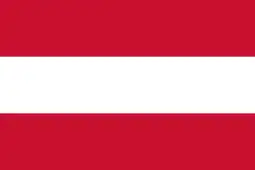 Sankt Pölten, Austria, September 29, 1957
Sankt Pölten, Austria, September 29, 1957 Kansas City, Missouri, United States since May 28, 1972[8][9]
Kansas City, Missouri, United States since May 28, 1972[8][9]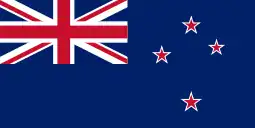 Christchurch, New Zealand, March 7, 1973
Christchurch, New Zealand, March 7, 1973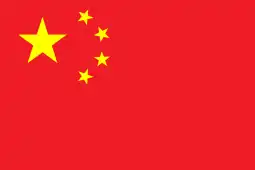 Zhenjiang, Jiangsu, China, November 18, 1997
Zhenjiang, Jiangsu, China, November 18, 1997
Local attractions


Kurashiki is the home of Japan's first museum for Western art, the Ohara Museum of Art. Established in 1930 by Magosaburō Ōhara, it contains paintings by El Greco, Monet, Matisse, Gauguin, and Renoir. The collection also presents fine examples of Asian and contemporary art. The main building is designed in the style of Neoclassicism.
The old merchant quarter is called the Bikan historical area. It contains many fine examples of 17th century wooden warehouses (kura, 倉) painted white with traditional black tiles, along a canal framed with weeping willows and filled with koi. The area has no electric poles in order to make it more closely resemble the look of the Meiji period. One of the city's former town halls was located in the Kurashiki Kan, a European style building constructed in 1917.
In 1997 a theme park called Tivoli (after the park of the same name in Copenhagen) opened near Kurashiki Station. After ten years of operation it was closed in 2008, with a massive debt.
The Great Seto Bridge connects the city to Sakaide in Kagawa Prefecture across the Inland Sea.
Kenzo Tange, winner of the 1987 Pritzker Prize for architecture, designed the former Kurashiki City Hall in 1960.
National Historic Sites
- Tatetsuki Site,Yaoi period ruins
- Yata Ōtsuka Kofun, Kofun period tumulus
Sports
Kurashiki has a variety of sports clubs, including former Japan Football League side Mitsubishi Mizushima.
- Mitsubishi Motors Mizushima FC - Soccer
- JX Nippon Oil & Energy Mizushima F.C. - Soccer
- Kurashiki Oceans - Baseball
- Kurashiki Peach Jacks - Baseball
Kurashiki was also the place where current J. League sides Vissel Kobe and Fagiano Okayama had their origins before moving.
Notable people from Kurashiki
- Ahn Young-Hak, Japanese-born North Korean football midfielder
- Umekichi Hiyama , Japanese female folk rhyme master belonging to the Rakugo Arts Association
- Senichi Hoshino, baseball player[10]
- Keitarou Izawa, a.k.a. Ichiyo Izawa, pianist, frontman of Appa, and former member of Tokyo Jihen
- Mikio Kariyama, professional shogi player
- Kibi no Makibi, scholar and noble during the Nara period
- Magosaburō Ōhara, businessman and philanthropist[11]
- Yasuharu Ōyama, shogi player, the 15th Lifetime Meijin[12][13]
- Daisuke Takahashi, figure skater[14]
- Joichiro Tatsuyoshi, boxer
- Isamu Nagato, actor
- Makiko Ohmoto, voice actress
- Keiji Tanaka, figure skater[15]
- Hisako Kanemoto, voice actress
- Megumi, actress
References
- "Kurashiki city official statistics" (in Japanese). Japan.
- 気象庁 / 平年値(年・月ごとの値). JMA. Retrieved May 2, 2022.
- 観測史上1~10位の値(年間を通じての値). JMA. Retrieved May 2, 2022.
- Kurashiki population statistics
- "Kurashiki's History". City of Kurashiki. August 7, 2006. Archived from the original on January 19, 2007. Retrieved August 8, 2006.
- ウリハッキョ一覧. Archived from the original on December 19, 2015. Retrieved October 14, 2015." ().
- Kurashiki's Sister/Friendship Cities
- Silvey, Jennifer (July 28, 2019). "Learn more about Kansas City's sister cities and possible travel destinations". Fox 4 KC. Retrieved January 19, 2021.
- "Japanese Tea Room and Garden". Kansas City Parks. Archived from the original on October 19, 2017. Retrieved October 18, 2017.
- 星野仙一記念館 [Hoshino Senichi Memorial Hall] (in Japanese). Kurashiki Convention & Visitors Bureau. Archived from the original on 6 October 2014. Retrieved 2 October 2014.
- 大原孫三郎から現代まで [From Magosaburo Ohara to the present] (in Japanese). Ohara Museum. Retrieved 2 October 2014.
- 7 大山名人記念館(倉敷市芸文館内 (in Japanese). Kurashiki City. Retrieved 30 September 2014.
- 棋士紹介:物故棋士一覧 (in Japanese). Japan Shogi Association. Archived from the original on 23 September 2014. Retrieved 30 September 2014.
- "Daisuke TAKAHASHI Biography". International Skating Union. Retrieved February 20, 2018.
- "Biography". International Skating Union. Retrieved February 20, 2018.
External links
- Official website (in Japanese)
- Kurashiki City Tourists official website
- Ryokan Kurashiki website
- Kurashiki's Sister/Friendship Cities

